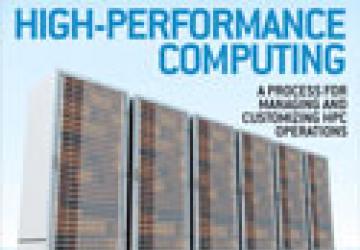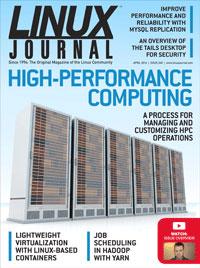April 2014 Issue of Linux Journal: High Performance Computing


Big Block Linux with a Four-Barrel Hemi
We often brag about how few resources Linux needs to operate: a Raspberry Pi or Beagle Board, in a Web browser (https://bellard.org/jslinux), or any number of other tiny places. Just because our beloved OS can run on a tiny scrap of hardware, however, certainly doesn't mean that's all it will do! In this issue, we talk about high-performance computing. Whether you're calculating trajectory corrections for a spacecraft millions of miles away or hashing transactions for the Bitcoin network, Linux is the perfect vehicle for all that computing power.
Reuven M. Lerner starts us out this month, this time with information on how to leverage geolocation information in your Web application. Whether you want to give your Web visitors a local weather forecast or just want to present them with location-appropriate options from your Web applications, geolocation is a powerful tool. Since the Internet is global, it's important to know where users are located. Reuven shows how to integrate geolocation awareness into your Web applications. Dave Taylor follows with the next in his series on Zombie Dice. It may feel like you're just making a cool game, but it's really just a ruse to help you learn something. (Well, it's a cool game too, but you really are learning!)
Kyle Rankin continues his series on Tails. When it comes to browsing the Web securely, you either can wear a tinfoil hat or look into something like Tails. The former won't help with security, but people at the coffee shop probably will leave you alone. Last month, Kyle explained how to install Tails, and this month, he describes using it. I took a completely different look at Linux this month. Instead of discussing security, I talk about entertainment-ivity. I recently set up my XBMC devices to share a centralized MySQL database, and I found it a little more difficult than I expected. In my column, I walk you through the process, and also discuss my mobile entertainment system: Plex. I get lots of e-mail regarding my home media setup, so this month I tell all.
Then we get into the nitty gritty of this month's issue. David Brown gives
some great processes for managing HPC clusters.
Linux containers continue to be the rage as the more efficient method for virtualization allows for far more dense computing. High-performance computing gets far more performance out of containers than out of traditional virtualized hardware. Rami Rosen discusses Linux containers and how the combination of lightweight virtualization and HPC will shape the future of cloud computing. And finally, Brian Trapp shows how to use MySQL's built in replication to help secure data integrity in your database implementations. My mantra is always "backup, backup, backup", but with the fast pace data changes in a database system, frequent backups aren't enough. With data replication, backups are still important, but the database administrator can sleep a little better between backup cycles.
This issue of Linux Journal has tons of HPC information, but if that's not your cup of penguin juice (eiw!), there's plenty of tech tips, product announcements and general Linux information to keep you entertained and educated. So whether you run Linux on your pocketwatch or need a bicycle to get from one end of your data center to the other, this issue is perfect for you. We hope you enjoy it as much as we enjoyed putting it together.
Watch the video overview for this issue:Available to Subscribers: April 1










